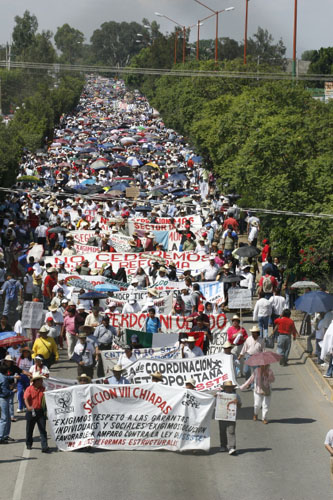Oaxaca June 14, 2007

by Diana
June 16, 2007
It’s 4am in Oaxaca on June 14, 2007, which marks one year since the protesting teachers were violently evicted from the zócalo. And this year, no one is going to sleep through it. Firecrackers sound throughout the city, one louder than the next, a steady crescendo that lasts several hours. All over the city, the dogs howl.
Last year at this time exactly, a thousand police armed with dogs, clubs, rubber bullets and indiscriminate quantities of teargas invaded the teachers’ sit-in and violently evicted protestors as well as destroying the radio that represented them, Radio Plantón.
Teachers had camped out in the center of the city, demanding government investments to improve quality of public education in Mexico. The attack on the teachers union sparked one of the biggest, most inclusive social movements in Oaxaca’s history, which, in spite of continuous repression, has bravely mobilized over the last year demanding the resignation of state governor Ulises Ruiz Ortiz and attention to collective discontent over lack of transparency, accountability and basic human rights.
La lucha sigue…
A year later, despite the arbitrary arrests, torture, and assassinations as well as divisionism, infiltration and attempts of political parties to co-opt the APPO, the popular movement commemorated their triumph in the face of last year’s repression in an impressive show of numbers.
Following the sounding of fireworks all over the city, perhaps a hundred thousand people marched from the airport into the zócalo in “a human river that stretched over ten kilometers” according to Noticias.
Under the pounding sun, a stream of colorful umbrellas floods the streets. Teachers march with their families, accompanied by the broad-based support of people representing all sectors of society and the seven regions of the state of Oaxaca. People carry homemade signs and chant the usual slogans, ““Ya cayó!” “We’ll bring Ulises down!” “Freedom for all Political Prisoners!” And, of course, among the most popular: “Zapata vive…la lucha sigue.” Zapata lives on…our struggle continues.
Despite the gravity of the repression over the past year, the marchers don’t seem to lack a sense of humor. One group has dressed up as the Federal Police, with hand-painted cardboard shields, masks and sticks. They parody the repressors in a comedy act that makes everyone double over with laughter. Another group has created a giant green worm in the style of the Chinese dragons, with twenty people dancing underneath controlling its movement through the crowd- with governor Ulises’ face as its head. Some carry papier-mâché helicopters.
Women carry giant puppets with cornhusk hair and the music of a brass band accompanies people who dance along. The smell of fresh spray paint fills the air- the usual grafiteros at work, claiming the walls of the city as one of the movement’s channels of communication.
Radio Plantón covers the events of the day, although their signal has been blocked in the northern part of the city. In the zócalo, people reflect on the last year of social struggle. Representatives from the Teachers Union, the APPO, the human rights organizations, student groups, community radios, the women’s body of the APPO, and the barricades all have a turn.
In the evening, barricades are put up all over the city- a reminder of the months of barricades in the fall- both of the solidarity, unity and democratic participation that they represented as well as of the sleepless nights and constant threats of the para-police forces that regularly attacked them.
In the zócalo, hundreds gather for the premiere of Compromiso Cumplido- True to My Pledge- the latest film produced by Mal de Ojo, a video collective that has documented the events of the past year. The documentary, dedicated to those murdered during the conflict, tells the story of many of the assassinations and human rights abuses starting last June 14, 2006. Through live footage at barricades and the plantón, interviews with widows and victims, contrasted with government propaganda on television, the video details the abuses and holds particular government officials accountable for the crimes.
The Supreme Court Minister, Genaro Góngora favors the creation of a committee that will investigate the crimes in Oaxaca. “Oaxaca may not be in flames, but that doesn’t mean that it doesn’t burn internally as a result of the consequences of the conflict which remain present and unresolved,” he said.
Oaxaca demands justice, demands accountability. It remains to be seen whether the situation can be resolved at the federal level, though many are dubious and hope instead to take their case to the Inter-American Court to address the state government’s violations of international law.
The March for Dignity of June 14 made it clear to all Oaxacans and to the nation that the demands remain the same, and that, indeed, the people have not wilted in their capacity to mobilize to insist that justice be served.
Tags: Mexico, Oaxaca, World Watching And Politics


Leave a Reply